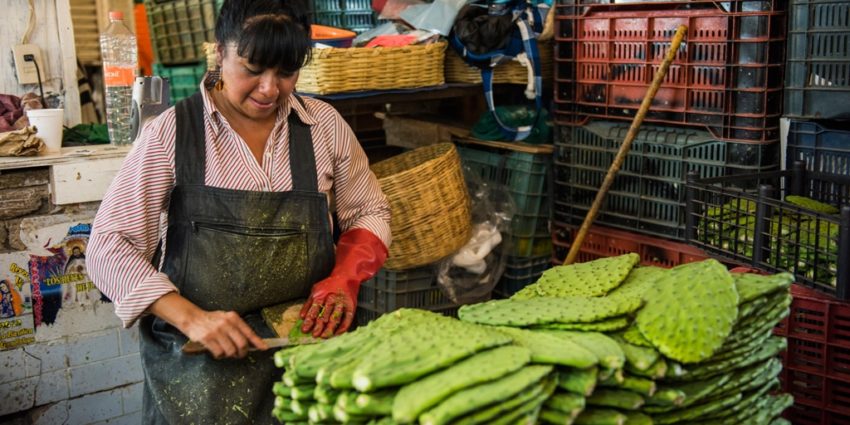Mapping Mexico City’s iconic street snack: The Tlacoyo

Elizabeth Hillbruner, a Mexico City resident and author of the blog La Cerda y La Cebollita, launched a project to map the tlacoyo vendors in her San Rafael neighborhood. Here’s more about how she did it.
What is a tlacoyo anyway?
Tlacoyos are stuffed, football shaped corn-masa patties topped with salsa, cooked cactus or sautéed greens and chopped onion,cilantro and cheese. Depending on the region and/or vendor, the fillings can vary from beans, cheese, and potatoes to even pork rinds. The masa or corn dough can be made with either blue or white corn.
They are usually pressed out by hand on the street and cooked on a comal, large flat griddle, and eaten on the sidewalk. Woman often sell bags of tlacoyos outside of markets to be re-heated at home, but for the most part, chilangos (Mexico City residents) enjoy them standing on street corners huddled around wood-fired comals.
Tracing Tlacoyos’ Roots
When I began researching tlacoyos, I found scant information on their history. Ricardo Muñoz´s Encyclopedic Dictionary of Mexican Gastronomy offered probably the most complete description of where they’re found — according to Muñoz, one can find tlacoyos in Morelos, the State of México, México City, Tlaxcala, Puebla and Veracruz. He also says they can be called clatoyo, clatloyo, tlatoyo, clayoyo, tlayoyo, tayoyo, tlatlaoyo y tlatloyo. I have also eaten tlacoyos in Guanajuato and while I have never been, I’ve been told by multiple people that tlacoyos are a common street food in the state of Hidalgo. These two states are not mentioned in Muñoz´s text.
What we do know, thanks to Bernardino de Sahagún, a Spanish missionary from the 16th century, is that tlacoyos were eaten before the arrival of the Spanish. In his text, General History of the Things of New Spain II he mentions the ixtac tlaxcalli etica tlaoyo which is described as a “very white tortilla that has inside uncooked bean flour.”
Mapping Tlacoyo Vendors in San Rafael
The idea behind Tlacoyografia, a mapping project I created a few years ago, was to document the location of all the stands that sell tlacoyos, my favorite street food, in my neighborhood of San Rafael in Mexico City. I started out walking the neighborhood’s 17 streets, on different days at different times, jotting down names and hours of each stand and interviewing the vendors.
I found some surprising facts:
*The stands have history. Ten of the stands have been around for more than 15 years. The oldest stand, called Cons Antojitos has been serving the neighborhood tlacoyos for over 58 years.
*The workers aren’t locals. Of the 14 stands, workers at nine live in Puebla or the State of México and commute into the city daily.
tlacoyografia*Most workers have a strong connection to agriculture. Eight stand-owners grow their own corn and make their masa from scratch, while a ninth buys the masa from a friend who grows and grinds the corn. The other five stands buy their masa at Mexico City tortillerías.
*Most stands use blue corn masa, as opposed to white. Interestingly enough, the nine tlacoyo vendors that use blue corn masa all reside outside the city.
The final stage: a completed map
For the final stage of my project, I worked with my friend, artist and graphic designer Israel Ruiz Hernández, to design a map of the 14 stands’ locations, names and hours. When I took it to show the vendors most sort of chuckled at it. Not because they didn’t like it; I think they thought the map was slightly bizarre. Local residents, on the other hand, were enthusiastic and seemed to find the map interesting and useful.
In the end, my small tlacoyo study was a great excuse to eat a lot of tlacoyos and get to know food vendors as well as my neighbours in San Rafael.
